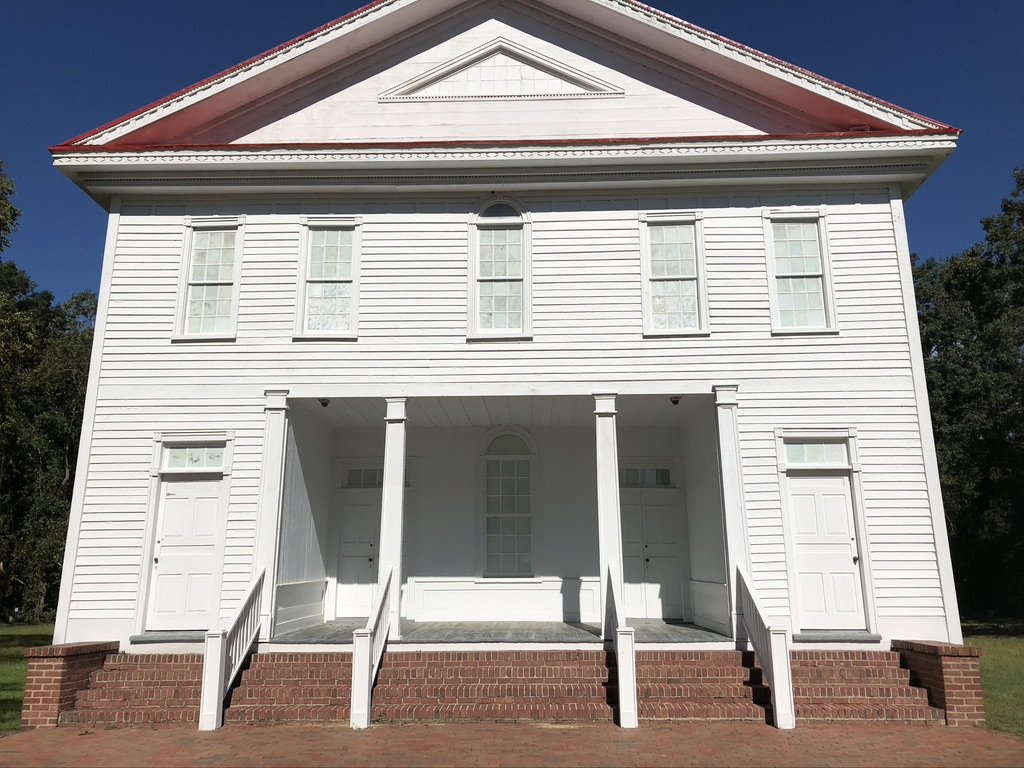Brief History of Old Bluff
Long before America’s proclamation of independence was heard around the world, European settlers — mainly Scot Highlanders — took up residence in the Cape Fear River valley. This bluff of land soon became a hallowed place where our ancestors would congregate to worship God, bury their dead, and converse with neighbors and sojourners.
The Old Bluff Presbyterian Church, founded in 1758, is one of the oldest churches in the Upper Cape Fear River Valley. For almost a century the religious services were conducted tin the Gaelic (pronounced “gal-lick,” not “gaylick”) language.
Down through the years three flags flew over Old Bluff. There was the Union Jack of Great Britain, the American flag, and the Confederate flag. Yet, while political loyalties changed, the devotion of the people remained tried and true.
The old Church, simple in design yet spacious. It is constructed of hand-hewn timbers and put together with hand-made nails and wooden pegs. Inside you see the pot-bellied stoves and the unique gas light fixtures. Unlike most churches of that period, the balcony extends on three sides inside of just along the back and accessible only from outside entrances.
The sanctuary, completed in 1853, is the third structure to house this congregation. In August, 1974, Old Bluff was entered on the National Register of Historic Places. The National Register is a list of properties “significant in American history, architecture, archeology, and culture — a comprehensive index of the significant physical evidence of our national patrimony.”
Prominent Monuments
Monument to the memory of the Reverend James Campbell, the pioneer Pastor of the upper Cape Fear River valley. Born in Campbelton, Kintyre, Scotland, about 1700, he came to America as a young man and to North Carolina in 1757. He was the earliest Presbyterian minister to settle permanently in this region and lead the churches he established. Because of his support of the Revolutionary cause, he was forced from the pulpit by the predominantly Loyalist congregation. After Independence was secured, he returned and died at his home across the river from this Church in 1780.
Anne Graham’s Epitaph. The memorial on this tombstone reads: “She was born in Scotland and died trusting in the merits of Jesus Christ.” This is a simple and yet fitting reminder to us to whom they bequeathed that which they valued most highly, their Christian faith, that they did worship their God and did claim His promise that He would be present.
Lovday’s Marker. Lovday, the wife of Duncan McNeill (of the Bluff), was the daughter of the Reverend James Campbell. She came to North Carolina when a young girl of nine or ten years and died in 1780, the same year of her father’s death.
Monument to the memory of Colonel Alexander McAllister, Patriot and revolutionary hero. Colonel in the Cumberland County Militia. He served several terms in the North Carolina Legislature and was a member of a Commission given the task to meet with and persuade to the Revolutionary cause the goodly number of Highlanders who elected to remain Loyalists to the Crown of England. History seems to indicate that neither he nor anyone else succeeded too well at that.
The Slave Graves. The custom was to bury slaves on land lower than their masters. Several stones, and a few wooden stakes were all that once marked these graves. Down through the years a few descendants of those early salves were buried there, but this was many years ago. This burial site, not maintained, is not a part of the Bluff Church property.
Cairn of Remembrance. Cairn is a Gaelic word meaning “a heap or pile of stones, loosely thrown together.” The Highland Scots, most too poor to afford expensive memorials, borrowed an idea from the Old Testament and erected cairns instead. This cairn was raised by members and other friends of Old Bluff in 1966. The stone to the left of the plaque as you face it is from the Isle of Skye, the last home of Flora Macdonald. The stone to the right of the plaque was once part of the Parish Kirk on the Isle of Jura. (The majority of the first members of the Old Bluff came from Jura or Skye.)
The Old Spring.
A visit to Old Bluff is not complete unless you visit the old spring and the river a few hundred yards beyond. This spring quenched the thirst of the Highlanders, both Patriot and Loyalist. It still flows, but very slowly now, partly due to the work of vandals. Hopefully this will soon be corrected and the old spring will once again quench the thirst of all who pass this way.
We hope that you will visit the Old Bluff and take a walking tour into history. We would invite you to visit, and visit often!
The Old Bluff Trust Fund was established in 1963. All money contributed is used to maintain Old Bluff and to continually seek new steps in restoration. A major restoration project was undertaken in 2002. You may wish to share with us in this work. If so, you are invited to send a contribution to:
OLD BLUFF TRUST FUND, Post Office Box 96, Wade, N.C. 28395-0096
An Extended History of Old Bluff
The Late Mac Williams developed a history of Old Bluff both in print and in video. You can watch the video below and on Youtube, and order a print copy by filling out the form, it only costs $15 and the proceeds go to the Old Bluff Tree Fund

